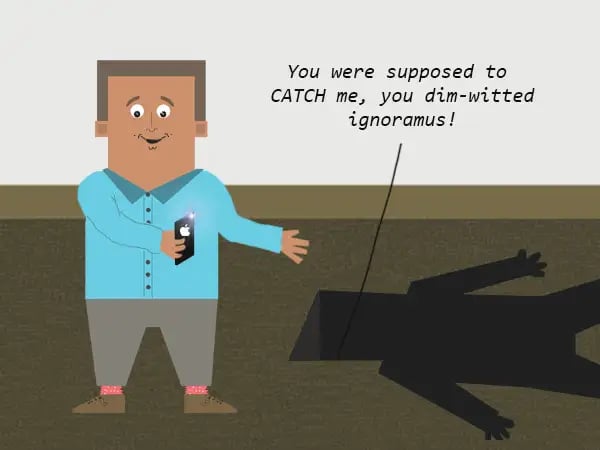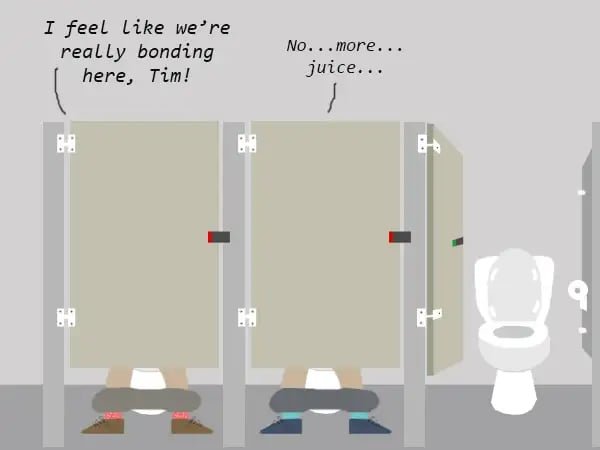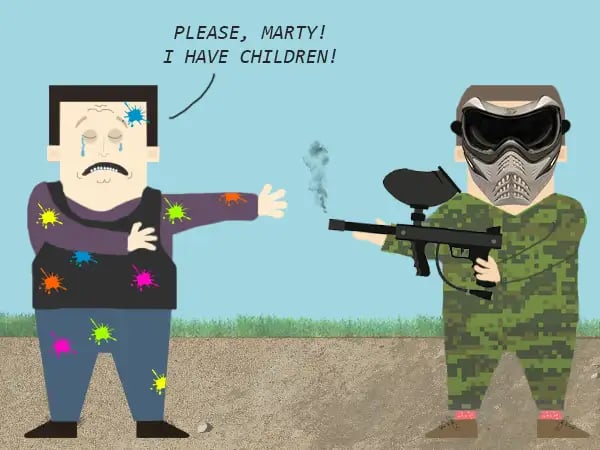Stephen Whigham was rounding third base during the late stages of a company kickball game when all hell broke loose.

Whigham, then the director of creative solutions at a South Carolina PR firm, had organized the game as a team-building experience for his subordinates. Weeks earlier, he’d booked a field and enticed employees with $440 worth of t-shirts and snacks.
But on game day things didn’t go according to plan.
On the final play, Whigham leaped in the air to avoid being tagged out — and when he landed, he shattered his tibia and fibula. The game ended with the flashing lights of an ambulance, reconstructive surgery, and a worker’s compensation lawsuit.
What had begun as a team-building initiative ended in Whigham’s departure from the company.

Nearly one-third of American employees report disliking team-building exercises — yet it’s a $46B-a-year business, and firms spend as much as $1k per employee in the hopes that “bonding” experiences like ropes courses and paintball tournaments will foster a more harmonious work environment.
But as Whigham learned, sometimes these activities go off the rail.
We asked our readers to anonymously submit their worst battle stories. Here are 5 tales of team-building gone awry. (Note: Some names have been anonymized by request.)
1. The trust fall fail
There is perhaps no team-building exercise more infamous than the trust fall, an activity whereby a person closes her eyes, crosses her arms, and blindly falls backwards into the arms of a colleague.
This activity is designed to build support and trust between employees. Unfortunately, it doesn’t always pan out this way.
Michael*, an editorial assistant at a book publisher, tells us that his employer once brought in a “corporate team-building coach” who broke the staff into pairs for a trust fall exercise. He was partnered with Tim, a marketing intern who was known around the office for his unrelenting Snapchats.
“I closed my eyes and let myself fall backward,” Michael recalls, “and SMACK, I landed flat on my back on the floor. When I looked up to yell at [Tim], he was standing there filming the entire thing on his phone, chuckling to himself.”
Michael says the incident has made it a little harder to trust his colleagues — but even when exercises like this work well, they do little to actually cultivate any meaningful change in employee trust.
“Leaders need to consistently do their bit, day in and day out, to ensure that trust gets built and stays in their teams,” says Revathi Turaga, a leadership coach. One-off exercises like the trust fall are not a shortcut.

2. The team juice cleansing from hell
Team juice cleanses emerged as a popular office fad around a decade ago.
At one point, juice companies like Cooler Cleanse and Juice Generation reported that as much as 30% of their business came from “office cleanses.” Though women make up two-thirds of all juicing enthusiasts, corporate cleanses are predominantly male, undertaken by hedge funds, law firms, and investment banks.
“These Type-A men have an all-or-none perspective,” one juice cleanse exec told Jezebel. “If they’re going to commit, they do it whole hog.”
Such was the case for Jules, an ex-Wall Street associate.
In 2012, his entire team participated in a 3-day, 18-juice cleanse called “Excavation,” meant to engage the team in a shared experience and boost productivity. It accomplished one of those things — though not in the intended fashion.
“The bathroom was straight up like the line to ride the teacups at Disneyland,” he says, “The whole office was just exploding with all kinds of noises. It set us back, like, a week.”

3. Paintballs to the wall
Believe it or not, some HR managers actually believe that the best way to forge lasting workplace relationships is to cart their team out to an old cornfield and let them loose to shoot each other in the face with pellets full of neon-colored dye.
For $89 per employee, one Pennsylvania-based paintball facility promises a corporate experience that promotes “communication, trust, strategic planning, leadership, time & resource management, flexible problem-solving, and adapting to a changing battlefield.”
Ben, a media strategist, tells us his company-wide paintball excursion had a strange twist that ended up negating any of these outcomes.
“We were playing a game of capture the flag, where you had to avoid getting shot by the other team,” he says. “And out of nowhere comes this person in full faux-military fatigues with an automatic paintball gun, just destroying everyone on both sides.”
The rogue paintballer, it turns out, was the company’s head of HR.
“She told us she was trying to cause an intentional conflict to see how we handled it as a team,” he says. “But she completely took the fun out of it. It felt like some weird guinea pig test or something.”

4. A riveting day on the ropes course
Ropes courses, used for team-building events since at least the early ‘90s, claim to impart a “significant” and “long-lasting” impact on risk-taking, introspection, confidence, and self-awareness.
“The challenges enable participants to expand their comfort zones—sometimes dramatically—and recognize fears that may block personal achievement,” writes Adventure Associates, a company that offers such activities.
Sometimes though, the comfort zone is left a little too far behind.
“We were on a company retreat on this ropes course probably 30 feet up in the air,” recalls Sheila, an accountant at a PR firm. “They harnessed us in and had us walk one-by-one across this beam, and the exec in front of me — this really reserved woman — stumbled and fell.”
“She was dangling in the air and just started screaming at the top of her lungs, dropping f-bombs left and right in front of the whole team,” she says. “It was quite a PR disaster.”

5. Lego for lunch
One of the easier team-building exercises to poke fun at is Lego Serious Play, a facilitation methodology created by the Lego Group in 2010.
Team members are given a pile of Legos and asked to “work through imaginary scenarios using visual three-dimensional Lego constructions.” It’s as cringe-worth as it sounds, though a vast nation of HR professionals claim that it promotes effective communication, engages the imagination, and leads to the discovery of new design opportunities.
But when employees are treated like kindergarteners, they act them too.
Kelly, a marketing professional, was participating in a Lego Serious Play where employees were given 10 minutes to visualize a problem they faced using Lego bricks. Midway through, two of her colleagues got bored.
“One of them told the other, ‘I’ll give you $20 if you swallow a Lego right now,’ and she actually did it,” she said. “I don’t think that’s the type of creative thinking [the employer] had in mind.”
The next day, says Kelly, the Lego gulper was “literally shitting bricks.”

Team-building exercises are a supplement — not a solution
These stories are a reminder that team-building activities in themselves are not a miracle cure for the underlying problems that exist at every company.
While certain team-building exercises have been shown to have positive effects on communication, problem-solving, and productivity, they are too often used as a Band-Aid solution for larger issues.
“A bunch of us in the team-building business see FAR too much spent on team-bonding activities,” writes professional consultant, Scott Simmerman. “Go-kart racing, paintball, firewalking — NONE of these things will impact results unless the facilitator is excellent at debriefing and can link the activity to some desired business output.”
Kristen Fyfe-Mills, an associate director at the Association for Talent Development, voices a similar thought.
“Sending a dysfunctional team off on a retreat isn’t going to make the team less dysfunctional,” she says. “There may be some nice moments, but without intentionality as to how those moments apply to the workplace, it’s just a nice day in the park.”
Or, you know, a not-so-great day in the park.

